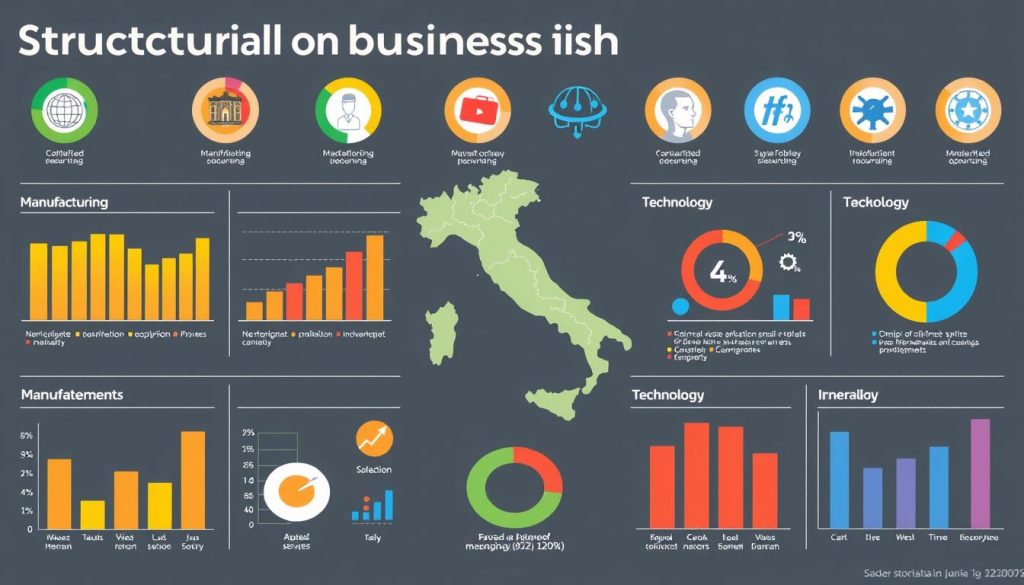In our look at Italy’s economy, we see how key structural business statistics (SBS) are. These stats help us understand how businesses perform and are set up in the country. With a GDP of $2.17 trillion in 2022, Italy’s economy is lively. Business value added is a key sign of how well the economy is doing.
Looking into SBS, we learn more about how different sectors add value and create jobs. The detailed data we collect shows us the changes in our economy. This helps those making policies and business leaders make better choices.
By studying investment, labour, and sector activity, we get a better picture of Italy’s economy. This knowledge helps us understand how the economy grows.
Overview of Business Value Added in Italy
The business value added in Italy has seen a strong recovery and growth. In 2022, businesses in Italy made over €1 trillion in nominal value added. This shows a remarkable annual growth rate of 11.3%. It highlights the resilience of various sectors and their significant contribution to the economy.
Annual Growth Rates and Sector Contributions
The construction sector led with a growth rate of 20.0%. Manufacturing and services sectors also showed strong growth, with rates of 9.7% and 11.2%, respectively. The number of enterprises in Italy rose to about 4.5 million, a 2.6% increase from the previous year. This growth shows the Italian economy’s dynamic nature, with turnover and gross operating surplus increasing by 22.1% and 13.8%, respectively, in 2022.
Comparative Analysis with Pre-Crisis Periods
An economic analysis of the post-crisis period shows interesting results. Compared to 2019, the value added has grown by 21.1%. This growth shows how different sectors have performed, especially as they adapt to new conditions. Enterprises in groups have also made significant contributions, accounting for 66.7% of total turnover and 57.3% of value added. The Italian economy’s resilience and adaptability indicate a strong recovery from tough economic times.

Structural Business Statistics in Italy
Understanding structural business statistics (SBS) is key to grasping Italy’s economic framework. SBS offers detailed data on various economic activities. It focuses on how different sectors perform.
Our study of SBS uncovers important facts about business health, especially for small and medium-sized enterprises (SMEs).
Definition and Importance of SBS
Structural business statistics are tools for collecting and sharing data on enterprise performance. They reveal:
- Value added generated
- Investment trends
- Labour productivity metrics
The role of SBS is huge. It helps shape economic policies and strategies for growth. By looking at sector data, policymakers can make better decisions to boost the economy.
Availability of Detailed Sectoral Data
We have a lot of detailed sectoral data. In 2022, Italian enterprises made over €1 trillion in value added. The construction sector grew by 20%.
Manufacturing grew by 9.7%, and services by 11.2%. This data is vital for seeing how sectors contribute to the economy. It helps them adapt to market changes.
With about 4.5 million enterprises in Italy, covering many sectors, this data is essential. It allows for a detailed economic analysis.
Current Trends in Italian Enterprises
Italian businesses are seeing big changes, with a big jump in their numbers. By 2022, there were about 4.5 million, up 2.6% from the year before. This growth matches the rise in jobs, showing a strong trend in the business world.
Increase in the Total Number of Enterprises
This growth in Italian businesses is more than just numbers. It shows a big change in trends across different areas. The rise is helped by government support and good economic conditions. For example, the Italian Special Economic Zone in Southern Italy makes things easier for businesses in sectors like farming and tourism.
Growth in Employment and Workforce Metrics
The Italian economy is getting stronger, with jobs up 4.5% from 2021 to 2022. Over 260,000 new jobs were created between July 2023 and July 2024. This shows a lively job market.
Job growth isn’t the same for everyone. For example, those aged 50-64 saw a 3% increase, while 25-34 year olds grew by 1.2%. These numbers show Italian companies are feeling more confident. They think things will keep getting better.
A net balance of +14% of businesses want to hire more people. This shows they’re optimistic about creating more jobs in the future.

The Role of SMEs in the Italian Economy
Small and medium-sized enterprises (SMEs) play a big role in Italy’s economy. They make up 99.8% of all businesses, creating jobs and boosting the economy. Their efforts show the strength and energy they add to the industrial sector.
Contributions of Micro, Small, and Medium Enterprises
Micro, small, and medium enterprises are key to Italy’s economy. They include about 97,000 businesses with sales under 50 million euros and 10 to 250 employees. These SMEs are vital for growth.
More than half of these businesses are doing well, showing they are stable. Despite tough times, like higher costs and less business, they still create over 65% of Italy’s value. They also export 53% of the country’s goods, beating the European average.
Employment Share and Economic Impact
SMEs are big employers in Italy, with 13 million people working for them. They are not just about numbers; they also drive innovation. Over 60% of them invest in digital technology, and one-third have increased their digital investments recently.
Programs like ‘Transition 5.0′ give tax breaks for digitalising industries. This shows SMEs’ dedication to staying competitive. As the economy faces challenges, SMEs’ role in job security and stability is crucial.
Sector-Based Analysis of Value Added and Employment
In our analysis, we see big differences in value added and employment across Italy’s industries. The manufacturing sector is a big player, adding €2,420 billion in value in 2022 and employing 30.0 million people. This shows it has higher labour productivity than sectors like accommodation and food services.
The distributive trades sector also plays a big role, with over 29.8 million people employed and €1,591 billion in value added. It shows its importance in jobs but has lower productivity. Policymakers need to understand these differences to improve productivity and job balance across sectors.
Our study highlights the need for smart economic planning. It shows which sectors are most important for Italy’s economy. Knowing this helps in growing the economy and creating jobs, benefiting everyone in the long run.

